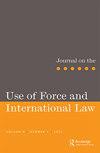除了言辞?评估作为人道主义干预规范的保护责任
Q3 Social Sciences
Journal on the Use of Force and International Law
Pub Date : 2018-01-02
DOI:10.1080/20531702.2018.1448156
引用次数: 3
摘要
摘要本文旨在考察保护责任(R2P)经过16年或更长时间的发展,是否已成为一项国际干预规范。作为一种理念,很明显,保护责任在国际话语中具有相当重要的地位。正如本文所示,多年来,在语言和概念框架的发展方面已经做了很多工作。然而,尽管这一架构对其作为国际规范的发展过程很重要,但有人认为,还需要更多的证据来支持保护责任已完全成为国际规范的说法,即保护责任影响和塑造国家决策的能力。本文章由计算机程序翻译,如有差异,请以英文原文为准。
Beyond rhetoric? Evaluating the Responsibility to Protect as a norm of humanitarian intervention
ABSTRACT The purpose of this article is to examine whether, after 16 years or more of its development, Responsibility to Protect (R2P) has emerged as an international norm of intervention. As an idea, it is clear that R2P has a considerable degree of prominence within international discourse. As will be shown in this article, there has been much work undertaken in the development of its language and conceptual framework over the years. However, whilst this architecture is important to the process of its development as an international norm, it will be argued that more is needed to support the claim that R2P has fully emerged as an international norm, that is, R2P’s capacity to influence and shape the decision-making of states.
求助全文
通过发布文献求助,成功后即可免费获取论文全文。
去求助
来源期刊

Journal on the Use of Force and International Law
Social Sciences-Law
CiteScore
1.10
自引率
0.00%
发文量
13
 求助内容:
求助内容: 应助结果提醒方式:
应助结果提醒方式:


